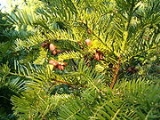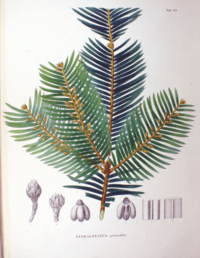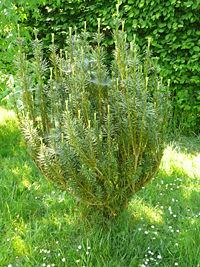
Cephalotaxus harringtonia
Encyclopedia
Cephalotaxus harringtonia, commonly known as Cowtail Pine or Japanese Plum Yew, is a coniferous bush or small tree in the plum yew family
. It is native to Japan
, but is occasionally utilised in western gardens and several cultivar
s exist for these purposes. Japanese plum yew has been in cultivation in Europe since 1829, many modern horticulturists are familiar with the Japanese species Cephalotaxus harringtonia, named in honor of the Earl of Harrington, one of the first to grow
the plant in a European garden.
s are green in colour, globular in shape and very small at only 1 mm in length. There is one rank of leaves present on either side of the shoot, and these rise up above it and curve slightly inwards, forming a narrow V-shape somewhat akin to a dove
's wings. The ranks are often vertical, but can be more flattened in shaded parts. The leaves
are broadly linear in shape and measure about 5 cm long by 0.3 cm wide. They are abruptly pointed at the apex, leathery in texture and a bright matte yellowish-green on the upper-surface. The abaxial surface, or underside of the leaves, shows two broad, pale to silvery stomatal bands.
 The species is diecious and the male plants are typically densely covered with pairs of flowers that are pale cream in colour, though they become brown with time, and globular in shape. They are borne on 2 to 4 mm stalks beneath each pair of leaves. Pollen
The species is diecious and the male plants are typically densely covered with pairs of flowers that are pale cream in colour, though they become brown with time, and globular in shape. They are borne on 2 to 4 mm stalks beneath each pair of leaves. Pollen
is released from March until May. The female individuals have two pairs of knob-like globose flowers that appear on curved stalks at the bases of the shoots. The fruit is obovoid in shape and measures 2.5 cm long by 1.5 cm wide. They are a smooth and pale green ín colour with dark green stipes, though when ripe they turn brown.
An Australian company, ChemGenex Pharmaceuticals Ltd., is developing a leukemia therapy called Omacetaxine derived from the leaves of this yew species.ChemGenex Poised for Rebound
when it was partially described by Thomas Andrew Knight
in 1839 and as such was named Taxus harringtonii. It was then moved into the current genus by Philipp Franz von Siebold
and Joseph Gerhard Zuccarini
in 1846, though with a new specific name, making the new name Cephalotaxus drupacea. Some botanists consider C. koreana
and C. sinensis
to be synonymous with C. harringtonia.
in the south to Hokkaidō
in the north. More specifically, it is found in Hondo in the Chiba Prefecture
on Mount Kiyosumi, which is located in the Awa District
within the Awa Province
. It is also found in the Nagasaki Prefecture
and the Hiroshima Prefecture
. The variety nana is found in eastern Honshū
as well as Hokkaidō
, most notably on seaside cliffs and in mountainous areas. They thrive in partial shade on deep, rich soils.
 C. harringtonia has been in cultivation in the United Kingdom
C. harringtonia has been in cultivation in the United Kingdom
since 1829 and is infrequnetly encountered as a garden specimen. Of the several species that exist in the genus, the Japanese plum yew is the one most often encountered in western gardens. Several cultivars exist:
Cephalotaxaceae
The family Cephalotaxaceae is a small grouping of conifers, with three genera and about 20 species, closely allied to the Taxaceae, and included in that family by some botanists. They are restricted to east Asia, except for two species of Torreya found in the southwest and southeast of the USA;...
. It is native to Japan
Japan
Japan is an island nation in East Asia. Located in the Pacific Ocean, it lies to the east of the Sea of Japan, China, North Korea, South Korea and Russia, stretching from the Sea of Okhotsk in the north to the East China Sea and Taiwan in the south...
, but is occasionally utilised in western gardens and several cultivar
Cultivar
A cultivar'Cultivar has two meanings as explained under Formal definition. When used in reference to a taxon, the word does not apply to an individual plant but to all those plants sharing the unique characteristics that define the cultivar. is a plant or group of plants selected for desirable...
s exist for these purposes. Japanese plum yew has been in cultivation in Europe since 1829, many modern horticulturists are familiar with the Japanese species Cephalotaxus harringtonia, named in honor of the Earl of Harrington, one of the first to grow
the plant in a European garden.
Description
New shoots of C. harringtonia remain green for three years after forming and have ribs at the leaf bases. The budBud
In botany, a bud is an undeveloped or embryonic shoot and normally occurs in the axil of a leaf or at the tip of the stem. Once formed, a bud may remain for some time in a dormant condition, or it may form a shoot immediately. Buds may be specialized to develop flowers or short shoots, or may have...
s are green in colour, globular in shape and very small at only 1 mm in length. There is one rank of leaves present on either side of the shoot, and these rise up above it and curve slightly inwards, forming a narrow V-shape somewhat akin to a dove
Dove
Pigeons and doves constitute the bird family Columbidae within the order Columbiformes, which include some 300 species of near passerines. In general terms "dove" and "pigeon" are used somewhat interchangeably...
's wings. The ranks are often vertical, but can be more flattened in shaded parts. The leaves
Leaf
A leaf is an organ of a vascular plant, as defined in botanical terms, and in particular in plant morphology. Foliage is a mass noun that refers to leaves as a feature of plants....
are broadly linear in shape and measure about 5 cm long by 0.3 cm wide. They are abruptly pointed at the apex, leathery in texture and a bright matte yellowish-green on the upper-surface. The abaxial surface, or underside of the leaves, shows two broad, pale to silvery stomatal bands.

Pollen
Pollen is a fine to coarse powder containing the microgametophytes of seed plants, which produce the male gametes . Pollen grains have a hard coat that protects the sperm cells during the process of their movement from the stamens to the pistil of flowering plants or from the male cone to the...
is released from March until May. The female individuals have two pairs of knob-like globose flowers that appear on curved stalks at the bases of the shoots. The fruit is obovoid in shape and measures 2.5 cm long by 1.5 cm wide. They are a smooth and pale green ín colour with dark green stipes, though when ripe they turn brown.
An Australian company, ChemGenex Pharmaceuticals Ltd., is developing a leukemia therapy called Omacetaxine derived from the leaves of this yew species.ChemGenex Poised for Rebound
Taxonomy
The Japanese plum yew was first considered to be a yewTaxus
Taxus is a genus of yews, small coniferous trees or shrubs in the yew family Taxaceae. They are relatively slow-growing and can be very long-lived, and reach heights of 1-40 m, with trunk diameters of up to 4 m...
when it was partially described by Thomas Andrew Knight
Thomas Andrew Knight
Thomas Andrew Knight, FRS was a horticulturalist and botanist who lived at Downton Castle, Herefordshire. He was the brother of Richard Payne Knight....
in 1839 and as such was named Taxus harringtonii. It was then moved into the current genus by Philipp Franz von Siebold
Philipp Franz von Siebold
Philipp Franz Balthasar von Siebold was a German physician and traveller. He was the first European to teach Western medicine in Japan...
and Joseph Gerhard Zuccarini
Joseph Gerhard Zuccarini
Joseph Gerhard Zuccarini was a German botanist, Professor of Botany at the University of München. He worked extensively with Philipp Franz von Siebold, assisting in describing his collections from Japan, but also described plants discovered in other areas, including Mexico.-References:...
in 1846, though with a new specific name, making the new name Cephalotaxus drupacea. Some botanists consider C. koreana
Cephalotaxus koreana
Cephalotaxus koreana, commonly called the Korean Plum Yew, is a coniferous shub or small tree in the plum yew family. It is native to Korea, Japan and northeast China. Some botanists consider it synonymous with C. harringtonia....
and C. sinensis
Cephalotaxus sinensis
Cephalotaxus sinensis is a coniferous shub or small tree in the plum yew family. It is native to central and southern China....
to be synonymous with C. harringtonia.
Range and habitat
C. harringtonia is present in Japan. Within Japan, the tree ranges from KyūshūKyushu
is the third largest island of Japan and most southwesterly of its four main islands. Its alternate ancient names include , , and . The historical regional name is referred to Kyushu and its surrounding islands....
in the south to Hokkaidō
Hokkaido
, formerly known as Ezo, Yezo, Yeso, or Yesso, is Japan's second largest island; it is also the largest and northernmost of Japan's 47 prefectural-level subdivisions. The Tsugaru Strait separates Hokkaido from Honshu, although the two islands are connected by the underwater railway Seikan Tunnel...
in the north. More specifically, it is found in Hondo in the Chiba Prefecture
Chiba Prefecture
is a prefecture of Japan located in the Kantō region and the Greater Tokyo Area. Its capital is Chiba City.- History :Chiba Prefecture was established on June 15, 1873 with the merger of Kisarazu Prefecture and Inba Prefecture...
on Mount Kiyosumi, which is located in the Awa District
Awa District, Chiba
is a district located in Chiba, Japan.As of August 2010, the district had an estimated population of 8,992 and a density of 198 persons per km². Its total area was 45.16 km².-History:...
within the Awa Province
Awa Province (Chiba)
was a province of Japan in the area of modern Chiba Prefecture. It lies on the tip of the Boso Peninsula , whose name takes its first kanji from the name of Awa Province and its second from Kazusa and Shimōsa Provinces. Its abbreviated form name was or...
. It is also found in the Nagasaki Prefecture
Nagasaki Prefecture
is a prefecture of Japan located on the island of Kyūshū. The capital is the city of Nagasaki.- History :Nagasaki Prefecture was created by merging of the western half of the former province of Hizen with the island provinces of Tsushima and Iki...
and the Hiroshima Prefecture
Hiroshima Prefecture
is a prefecture of Japan located in the Chūgoku region on Honshu island. The capital is the city of Hiroshima.- History :The area around Hiroshima was formerly divided into Bingo Province and Aki Province. This location has been a center of trade and culture since the beginning of Japan's recorded...
. The variety nana is found in eastern Honshū
Honshu
is the largest island of Japan. The nation's main island, it is south of Hokkaido across the Tsugaru Strait, north of Shikoku across the Inland Sea, and northeast of Kyushu across the Kanmon Strait...
as well as Hokkaidō
Hokkaido
, formerly known as Ezo, Yezo, Yeso, or Yesso, is Japan's second largest island; it is also the largest and northernmost of Japan's 47 prefectural-level subdivisions. The Tsugaru Strait separates Hokkaido from Honshu, although the two islands are connected by the underwater railway Seikan Tunnel...
, most notably on seaside cliffs and in mountainous areas. They thrive in partial shade on deep, rich soils.
Cultivation

United Kingdom
The United Kingdom of Great Britain and Northern IrelandIn the United Kingdom and Dependencies, other languages have been officially recognised as legitimate autochthonous languages under the European Charter for Regional or Minority Languages...
since 1829 and is infrequnetly encountered as a garden specimen. Of the several species that exist in the genus, the Japanese plum yew is the one most often encountered in western gardens. Several cultivars exist:
- 'Fastigiata' was first selected in 1861 in Japan. It grows to 6 metres in height and it characterised by its broad cluster of erect stems and very dark green leaves that spread all around the stem and are strongly decurved. The shoots are unbranched in the upper parts of the plant, while the lower parts have somewhat chaotic projecting side-shoots that hang down and contain leaves in flat ranks. The flowers are also inconspicuous.
See also
- Omacetaxine mepesuccinate, an alkaloid from this plant and a potential anti-cancer drug

